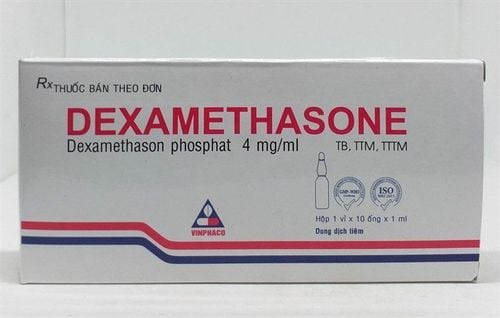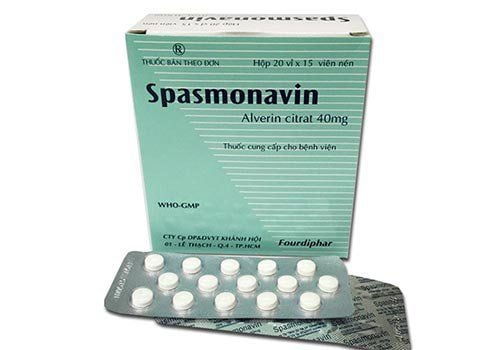This is an automatically translated article.
Desbebe drug is known to treat allergies and is used in cases of hypersensitivity. Before intending to use Desbebe, patients need to know the information so that the treatment can be more effective.
1. What is Desbebe?
Desbebe has the main ingredient Desloratadine, which belongs to the group of anti-allergic drugs. The drug is prepared in the form of oral syrup in 60ml glass bottles with the content of Desloratadin accounted for 2.5mg/5ml.Desbebe drug is prescribed by doctors for many subjects from adults, adolescents to children over 1 year old with symptoms of: allergic rhinitis and acute urticaria.
2. What does Desbebe do?
Desloratadine is a non-sedating, long-acting histamine antagonist with selective peripheral H1-receptor antagonist activity. After oral administration, desloratadine selectively blocks peripheral histamine H1 receptors, since the substance is not allowed to enter the central nervous system.Desloratadine has demonstrated antiallergic properties from in vitro studies. These include inhibiting the release of proinflammatory cytokines such as IL-4, IL-6, IL-8, and IL-13 from human mast cells/basophils, as well as inhibiting the expression of the adhesion molecule P -selectin on endothelial cells. The clinical relevance of these observations remains to be confirmed.
Desloratadine plasma concentrations can be detected within 30 minutes of administration of desloratadine in adults and adolescents. Desloratadine is well absorbed with maximum concentrations reached after about 3 hours, the terminal half-life is about 27 hours. The extent of accumulation of desloratadine is consistent with its half-life (approximately 27 hours) and the frequency of once-daily dosing. The bioavailability of desloratadine is dose proportional in the range of 5 mg to 20 mg.
In a series of pharmacokinetic and clinical trials, 6% of subjects achieved higher concentrations of desloratadine. The prevalence of this poor metabolizer phenotype is comparable in adult subjects (6%) and children 2 to 11 years old (6%), and in blacks (18% adults, 16 years old). % children) compared with Caucasians (2% adults, 3% children) in both populations.
In a multiple-dose pharmacokinetic study performed with a tablet formulation in healthy adult subjects, four subjects were found to be poor metabolizers of desloratadine. These subjects had approximately 3-fold higher Cmax at approximately 7 hours with a terminal half-life of approximately 89 hours.
Similar pharmacokinetic parameters were observed in a multiple-dose pharmacokinetic study performed with the syrup formulation in pediatric subjects 2 to 11 years of age diagnosed with the disease. allergic rhinitis.
The exposure (AUC) to desloratadine was approximately 6 times higher and C max about 3 to 4 times higher at 3-6 hours with a terminal half-life of about 120 hours. Exposure is similar in adults and in children with poor metabolisers when treated with age-appropriate doses. The overall safety profile of these subjects did not differ from the safety profile of the general population. The effects of desloratadine in poor metabolisers < 2 years of age have not been studied.
In single-dose studies, at the recommended dose, pediatric patients had maximum desloratadine AUC and C values comparable to those of adults receiving 5 mg desloratadine syrup.
3. Issues to note when using Desbebe
According to evaluation, in the process of using the drug, the patient may encounter a few side effects as follows:
Headache, dizziness, feeling sleepy anytime, anywhere. Flatulence, abdominal pain, nausea, vomiting, dry mouth, bitter mouth. Muscle pain, even muscle weakness. Pharyngitis 3.1 Interactions when taking Desloratadine drugs increase the effect of:
Alcohol or alcoholic beverages. Anticholinergic drugs. CNS depressants Selective reuptake inhibitor Serotonin (medicine for depression) Hydroxyzine (antihistamine). Pramlintide (diabetic drug) Droperidol (an antiemetic) may increase the concentration and effect, desloratadine when used concurrently. Use caution when using Desbebe when you are using the following drugs (due to the risk of interactions):
Macrolide antibiotics: Azithromycin, Erythromycin. Antifungal: Ketoconazole. Antihistamine H2: Cimetidine. 3.2. Precautionary statements Pregnancy A large amount of data on pregnant women (more than 1,000 pregnancy outcomes) indicate no malformations or neonatal toxicity with desloratadine. Animal studies have not shown direct or indirect harmful effects on reproductive toxicity. As a precaution, it is best to avoid the use of desloratadine during pregnancy.
Lactation Desloratadine has been identified in breastfed infants/infants of treated women. The effects of desloratadine on neonates/infants are unknown. A decision must be made whether to discontinue nursing or to discontinue/discontinue treatment with desloratadine taking into account the benefit of breastfeeding to the child and the benefit of therapy to the woman.
Convulsions Desloratadine should be used with caution in patients with a medical or family history of seizures, and mainly young children, who are susceptible to new seizures during treatment with desloratadine. Healthcare providers may consider discontinuing desloratadine in patients who experience seizures during treatment.
Children In children under 2 years of age, the diagnosis of allergic rhinitis is particularly difficult to distinguish from other forms of rhinitis. The absence of upper respiratory tract infection or structural abnormalities should be considered, as well as the patient history, physical examination, and appropriate laboratory and skin tests.
Approximately 6% of adults and children 2 to 11 years of age are phenotypically poor metabolizers of desloratadine and have higher exposures. The safety profile of desloratadine in children 2 to 11 years of age who are poor metabolisers is the same as in children who are normal metabolizers.
4. How to use Desbebe effectively?
The recommended dosage for adults is 2 full teaspoons (5mg in 10ml), taken once a day. In patients with hepatic or renal impairment, the recommended dose of desloratadine is 5 mg every other day.
The recommended dose for children is:
Children 2 - 5 years old: take 1/2 teaspoon (1.25mg in 2.5ml) once daily. Children 6-11 years old: take 1 full teaspoon (2.5mg in 5ml) once a day. Children over 12 years: take 2 full teaspoons (5mg in 10ml) once a day. Do not give the medicine to children under 2 years old. In short, knowing the information about the drug Desbebe always helps the process of using it to achieve high efficiency as well as limit unnecessary side effects to the patient's health.
Please dial HOTLINE for more information or register for an appointment HERE. Download MyVinmec app to make appointments faster and to manage your bookings easily.













